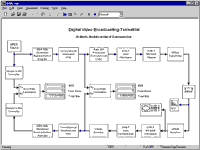 |
 System-level design requires high-level modeling to capture an overall
product concept and lower level modeling to specify implementation details. For complete end-to-end simulations, you need to be able to integrate different components including analog/mixed signal, DSP, digital communications, and control
logic. Once you've modeled your system, you need to be able to see if it performs to your specifications, exploring design trade-offs and parameter tuning to optimize performance. System-level design requires high-level modeling to capture an overall
product concept and lower level modeling to specify implementation details. For complete end-to-end simulations, you need to be able to integrate different components including analog/mixed signal, DSP, digital communications, and control
logic. Once you've modeled your system, you need to be able to see if it performs to your specifications, exploring design trade-offs and parameter tuning to optimize performance.
All these tasks can be achieved with Simulink, the hierarchical block-diagram design and simulation tool. It can model single and multi-channel data, and linear and non-linear components. It can simulate digital, analog, and mixed-signal
components. Application libraries such as the DSP Blockset and the Communications Blockset provide all the common blocks found in any DSP or digital communications system allowing you to build a complete end-to-end communications system.
Its companion product Stateflow® can model control logic event driven systems. And all these tools are integrated with MATLAB®, the world's leading DSP algorithm development tool.
The DSP Design Suite and the Communications Design Suite contain all products necessary to perform system-level design of DSP or digital communications systems.
Component Design and Integration
 Most DSP-based communications and multi-media products have these main components: analog/mixed-signal, DSP or digital communications, and control logic. When design teams work
independently and use different tools they can't easily simulate component interactions or test the whole system. Simulink can be used to design DSP, digital communications, analog/mixed-signal or control logic components. All these components
can be simulated together in one environment, so when Simulink is used as a common tool for all design teams, you can simulate component interactions and test the whole system. Most DSP-based communications and multi-media products have these main components: analog/mixed-signal, DSP or digital communications, and control logic. When design teams work
independently and use different tools they can't easily simulate component interactions or test the whole system. Simulink can be used to design DSP, digital communications, analog/mixed-signal or control logic components. All these components
can be simulated together in one environment, so when Simulink is used as a common tool for all design teams, you can simulate component interactions and test the whole system.
DSP
The MathWorks products are the industry standard for DSP design. The DSP Blockset provides every standard DSP component including filters, FFTs, correlation, adaptive or multirate filters, and statistics. The Signal Processing Toolbox
contains every standard signal or system analysis method such as filter design, filter analysis, frequency response and spectral estimation, as well as advanced methods. The Fixed-Point Blockset contains variable precision blocks for simple
operations like arithmetic and filters.
Digital Communications
The Communications Blockset provides the necessary building blocks such as modulation, error coding, interleaving and channel models, to construct a wide range of communication systems. The Communications Toolbox provides additional support
functionality for communication algorithm development.
Analog/Mixed-Signal
Analog-mixed-signal components-like phase-locked loops and A/D converters-traditionally designed with analog circuit simulators, can be more quickly designed and simulated as a behavioral model in Simulink. Detailed mathematical component
or circuit analysis can be performed in MATLAB and in application toolboxes.
Control Logic
Control logic designs such as protocols and acknowledgements are specified with state-diagrams and require event-driven simulation. These are provided with Stateflow, which allows graphical design and simulation of finite-state machines.
Simulink Key Features Demonstrations
These demonstrations provide tutorials on Simulink's key features, including the block libraries, model construction, multi-channel data, multirate digital and analog signals, system hierarchy, C Code integration and MATLAB integration.
For more information on The MathWorks Sytem-Level Design solutions click here
|

